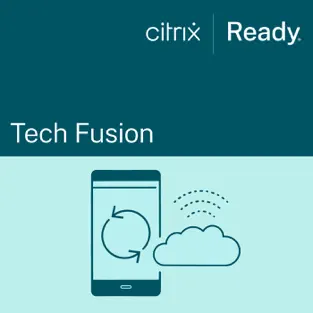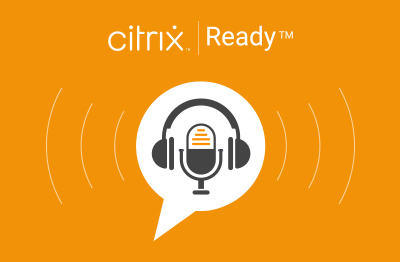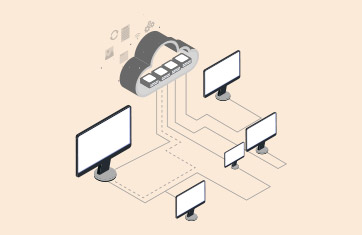 The Citrix Ready team recently recorded a podcast with eG Innovations for their Tech Fusion podcast series. Hosted by Neil C. Hughes from The Tech Blog Writer, Wendy Howard from eG Innovations’ pre-sales, and Manjunatha Gali from Citrix Ready discussed how eG Enterprise enhances and goes beyond native Citrix monitoring tools with its unique observability and automation features.
The Citrix Ready team recently recorded a podcast with eG Innovations for their Tech Fusion podcast series. Hosted by Neil C. Hughes from The Tech Blog Writer, Wendy Howard from eG Innovations’ pre-sales, and Manjunatha Gali from Citrix Ready discussed how eG Enterprise enhances and goes beyond native Citrix monitoring tools with its unique observability and automation features.
You can listen to the podcast:
They covered a wide range of topics, including:
- The difference between Monitoring and Observability, explaining how observability tools include features that automate setting metric thresholds and alerts, provide root-cause diagnostics and can even provide automated remediation
- Overcoming many of the challenges that modern Citrix deployments involve, including complex environments such as Citrix Cloud and cloud-hybrid architectures – and even those including multiple types of digital workspaces
- How Citrix administrators can leverage eG Enterprise to automate common Citrix maintenance tasks such as restoring Unregistered VDAs, resolving High Disk space usage, adjusting modified and standby memory usage and to free up resources associated with idle or disconnected sessions
The full transcript of the podcast appears below:
Intro: Combining two technologies can often be cumbersome. On this podcast you will learn how Citrix technology alliances are solving industry challenges and empowering people to unlock their full potential. Here is your host, tech columnist, podcaster and bestselling author, Neil C. Hughes.
Neil C. Hughes: How often do you think about the intricate dance of technology that underpins our digital workspaces? Well, in today’s episode, we’re privileged to host Wendy Howard, Lead Solutions Engineer at eG Innovations on the West Coast, alongside my friend Manju over at Citrix.
Wendy brings a wealth of experience from her journey in tech from the service desk of a major hospital to becoming a CompTIA subject matter expert and a Citrix certified admin. Together they’re going to unravel layers of performance, monitoring, observability and the critical role that these elements play in optimizing and automating Citrix environments.
You can expect to delve deep into the world of IT, exploring how eG Innovations is transforming the way we understand and manage complex digital environments. But enough from me, let’s get today’s guests on the podcast now. So – a massive warm – welcome to the show, Wendy can you tell everyone listening a little about who you are and what you do.
Wendy: Hi Neil. Thanks for having me. My name is Wendy Howard. I’m a lead solutions engineer at eG Innovations on the West Coast. I work in pre-sales, where I demo our solution, set up proof of concepts, and analyze data for customers. I’m also a CompTIA subject matter expert and a Citrix certified admin.
Neil: A big warm welcome to the show. And Manju – you’ve been on… I don’t know how many episodes now.
Manju: Yes, let’s do it one more time. Thank you for having me, Neil here. So my name is Manjunatha. I am the senior manager for the Citrix Ready Program at Citrix. Through this program we help technology partners to partner with Citrix, help develop their product to integrate with our products and services and once they are developed, we help them to validate their product as Citrix Ready by showing the interoperability of their product with our products and services. So I primarily work with key partners who help address our enterprise customer challenges and address business gaps. Essentially, new partners like eG Innovations for example.
Neil: Excellent. And there’s so much I’m looking forward to talking with you both about today. Wendy, I believe you’ve got quite an origin story. Can you tell me about how your relationship with Citrix first began?
Wendy: Yes, in my previous job. I worked at a service desk for a major hospital here in Central Oregon. Then luckily I got promoted to the Citrix team because nobody wants to stay at the service desk forever – right? Where I worked with a small team and we managed and supported over 1500 users on both XenApp and XenDesktop.
So I kind of got thrown into the water and then IT ended up purchasing the eG Innovations solution and I became the admin for it. I absolutely loved using it. I was just in awe by the demo that I received by the account Rep that came in to show us the product. And then about a year after using it, I decided that I wanted to work for eG.
Then Citrix gave me a Citrix Synergy pass. So I went to Synergy pre-pandemic and we got to get together with all the other Citrix admins and visited the booths there. They had an eG booth there and I decided that I wanted to speak to them and try to get my foot in the door and get a job with them.
And I did just that. I got a meeting with the CTO and the salesperson that was there for the hospital account and somehow I convinced them to start the hiring process for me, and I ended up starting working at eG a few months later and now that salesperson as my manager. So it’s a fun story and I’m so, so happy. I ended up here.
Neil: Wow, what an incredible story looking at is as a fellow ex-service desk guy myself – that’s how I started out on my journey. Manju – have you ever been on the service desk?
Manju: Yes, I started my career with service desk like Wendy. So I was a tier one or level one agent – that’s how I started my career supporting Citrix back then. It was called Presentation Server only. We didn’t yet have XenDesktop or virtual desktops. So that’s how and where I began my journey, working for Citrix products level one or tier one, then Level 2 and Level 3 and then consultant and architect and that’s how I got into Citrix and into this technical marketing role, now owning the Citrix Ready program.
Neil: Never trust a techie that didn’t start by earning their stripes on the service desk. It certainly grounds you for life. For today’s conversation, though, just to set the scene, can you set the record straight and explain the difference between monitoring and observability? Because it’s such a huge talking point right now. And they often get confused. So, let’s start by just explaining what they are and what they are not?
Wendy: Yes, I can help answer that and then Manju you can chime in, because I’d love to hear different opinions on this. Basically, performance monitoring will identify when something went wrong and some bottlenecks and give you maybe some insights. But it doesn’t actually tell you the root cause of issues, whereas observability will help you with a comprehensive view of them. It makes it easier to diagnose and troubleshoot because it correlates data from all kinds of different sources. eG Enterprise is an observability solution, not a monitoring tool. So I’ve found that it does answer why things are happening, why things are going wrong. And it also helps the admin understand how to better optimize their environment to make it perform better.
Neil: Perfectly described there. Manju, anything you please add to that?
Manju: Wendy described it exactly. If you look at it from the IT operation Team perspective, an observability tool helps observe and gain deeper insights. For example, like health and status of different applications and resources, and of hardware across the IT infrastructure, at the same time. By gathering these insights from each systems data, the IT team will be able to proactively detect any kind of abnormalities and analyse issues and resolve before they occur. Observability wouldn’t be possible without monitoring, so in general we can say monitoring is defined as the collection of data which is pulled from different IT systems.
Neil: Wendy, you mentioned the ability of eG innovations to optimize Citrix environments. Can I let you elaborate on that. On how automation processes works and also the impacts on resource usage and session management for example.
Wendy: Sure. eG Enterprise has some built-in solution capabilities that will automate things so the Citrix Admin doesn’t spend their precious time doing what we have we all did as a Citrix admin – you understand there’s a lot of tedious work, So while eG’s monitoring Citrix it will observe things like the idle sessions or the high resource usage on VDAs and it can even fix issues with VDA registration. So when I say fix it, that’s kind of usually a manual intervention without a solution like this. Even kicking off a script will take up time, which means you’re spending time on these boring tasks where you end up managing the care and feeding of Citrix itself.
Whereas if you fully automate a task in this context, it means like a handful of things you get a fix before users are aware. Like Manju was saying, you want something before your users know you need it. There’s no more manual intervention and the issues are resolved quickly and then you have like more faith in your business continuity.
Neil: And Manju, you’ve highlighted that eG innovations offer far more than just monitoring. So can you explain how these additional capabilities that we’re talking about here, how they support Citrix environments and also what differentiates the solution from standard monitoring tools?
Manju: Yes, certainly. So this is a very interesting question and definitely there is some overlap with what Citrix does today and what eG does as well. As Wendy mentioned, it’s probably what we just discussed few seconds ago about the difference between observability and monitoring. So at Citrix, we have our own monitoring and troubleshooting tools called Sites Director, which is basically used by the administrators and helpdesk users for monitoring and troubleshooting Citrix on-prem and Citrix Cloud setups and user related issues predominantly.
Then we have Citrix Analytics for performance, this tool gives administrators the data to improve the performance of the overall environment with real time actionable data. It also provides user centric experience, application and infrastructure metrics. Performance through advanced analytics data. It provides multi-site aggregation and reporting as well. Customers who run with multiple sites can consume data from a single console and all this is done via Citrix Tools now.
If you look at how a typical infrastructure would be spread right – many customers would have their infrastructure spread across cloud or on-prem, or sometimes hybrid, most of the times actually these days. So, what our customers need also is a tool which has the ability to gather all these insights from Director, from Analytics and from other tools and solutions related to other vendor hardware devices that they have within their infrastructure. And it should help to observe and gain deeper insights like health and status of orgs, devices and applications, and any infrastructure components for that matter. Which will help IT teams to proactively detect abnormalities, analyze issues and resolve them before they occur, and this is what observability beyond monitoring means and eG has this ability to do this from day one after we install and configure and start analyzing our infrastructure.
Neil: At the very beginning of our conversation, we were talking about how we’ve all spent time on the service desk. That’s where we earned our stripes. I suspect that all three of us have seen a certain amount of blame games when it comes into troubleshooting in IT. So, Manju, how does eG Innovations help Citrix admins quickly pinpoint the actual root cause of problems, whether it’s a Citrix, Citrix issue or something else, it’s something that we’ve all seen.
Manju: Yes, certainly even I did that in my past – there is no shortcut to that. So going back to what we just discussed, right, so without such tools like eG Enterprise for example, IT teams such as storage or Windows or networking or Citrix or cloud, any teams for that matter – rightly, they all will have this sense of feeling that this is definitely not my issue. What were customers reporting, right? So – they actually meant to say is “this is not my product issue” and they will say “from my experience this is related to something else”, “Please check with, you the networking team or the Windows team…”. So most of us have seen this done this and experienced this and in some organizations they are still doing this, having inadequate monitoring tools. Tools like eG will certainly be very handy and help in reducing such blame games. So I must say it helps in preventing issues in the first place, before they occur, and also in cases if they occur beyond the scope, it helps in finding the root cause without much trouble.
Wendy: I’ll chime in on this one – I saw that blame game thing as well on the infrastructure team at the hospital – where whenever there was an outage, we would spin a wheel of blame and wherever it landed. We would say – it’s their fault – so it could say – like network or database or usually Citrix and the way around that would have been to put in an observability solution monitoring. Every server, every tier to collect data and then you know you’re no longer pointing fingers because you know it used to be good enough to say, “It’s not Citrix! Go figure it out”. But now the right thing to do, the best thing for businesses, is to say it’s not Citrix but it’s this other thing over there because I have the tools to show you.
Neil: Absolutely love that Wendy! And I suspect we’ve got techies all over the world creating their own wheel of blame to have placed by their desk right now!
You’ve touched on the technical details of your newest product a few moments ago as well, including automation features to bring to life everything that we’re talking about and how we’re moving away from that wheel of blame. Can you expand on these features, and how they specifically aid Citrix admins in that real time problem resolution?
Wendy: Absolutely. So there are four specific things that eG can do to help the admins with problems, and we can automate these. I’ll just list the four of them – restoring unregistered VDAs, resolving high disc space usage, automatically adjusting modified and standby memory usage, and freeing up resources for idle or disconnected sessions.
Now I’m going to explain each one of these here. So the first one – restoring unregistered VDAs. When a VDA is an unregistered state, usually it’s deemed unusable and most of us admins have experienced this problem, but we never seem to catch it fast enough. We literally have to be staring at the Citrix Studio to understand what just happened. It’s a classic problem with a very simple solution in eG – You check a box to automate the action of restarting the Citrix services when it sees it’s unregistered or it can restart the machine itself. Super easy!
The next one is for disk space usage. We all know what happens when disks go to 100% and admins want to prevent that. You need a solution like eG to help to clean up – it could be to due to temp files, Windows Update files or application cache files. As long as you know the file path then you enable the action to automate cleanup and you give it the path and when to start. So for example, I may want to start the disk cleanup when it’s at 80% usage and then I have like 4 different folders to clean.
The next one is automatically adjusting modified memory. In Windows servers modified memory is the memory that was allocated by application and then removed from the applications working set because it hasn’t been used in a long time. There’s another type of memory called standby memory, and it contains pages that have been removed from the process working sets, but are still linked to their working sets, and that’s essentially a cache. Standby memory is supposed to be released, but it doesn’t always happen. This is another simple automation action in eG., where you can select when to perform the cleanup of either of those memory types.
Freeing up precious resources such as memory and CPU, especially in the Cloud, is important. You want to free up resources from idle or disconnected sessions on Windows, when they’re just sitting there taking up resources churning away. eG can figure out when it’s time to actually take the process and lower the priority, so then that gives OS the OS preference to other user sessions. So, we’re looking at it from a user session point of. We can lower that user’s processes and then if they start working again, maybe they reconnected, maybe they go active. Because we are, you know, watching the active and idle, then the priority will change back. And then one last option, is for disconnected sessions, eG can just automatically log off sessions after a period of time. So those were some fast, easy ways for Citrix admins to save time with. eG’s automation.
Neil: So much gold in your answer there. Those four – restoring unregistered VDAs, resolving high disk space usage, automatically adjusting modifying standby memory usage and freeing up those valuable resources for idle or disconnected sessions.
Manju, you’ve mentioned a few months ago that most issues attributed to Citrix are actually completely unrelated to it, so how does this solution help in changing this misconception and ultimately accurately identifying the real issue?
Manju: Yes, certainly. I’m glad we have solutions like eG Innovations in place and most of our existing customers do use one or another observability kind of solution, especially from eG, which is very, very popular.
In general, most of the users complaining think what they are seeing is that Citrix is broken because they complain about what they see on the system. The first thing they do is launch or open the Citrix Workspace App and launch their Citrix apps and desktops and when it is not launched or when they’re not able to launch the published apps on desktop – they think that Citrix is broken, or Citrix is not working as expected.
It’s quite natural that because they have very less visibility or it is too complex for them to understand what runs behind the scene or behind the Citrix infrastructure, which could cause an issue or to that particular issue that they’re facing. Typically, a user says Citrix is not working or a session is slow or sessions are not launching any applications or desktop. Anything that they say in association with Citrix is usually not related to Citrix. That’s where solutions like eG come in and explains all those issues. It is handy to proactively resolve issues.
In general, there are many resources like operating systems for example, or any hardware or network or storage that runs behind [Citrix] and could have caused this issue. So it is really important for the IT team to understand the crux of the issue. Understand the architecture and then start troubleshooting and like I mentioned multiple times solutions from eG makes IT lives very easy. With help of the data it can aggregate, and the granularity it provides to find the root causes, helping to identify the accurate cause and eliminate that or put it aside and then fix the issue first and then troubleshoot that root cause device or anything for that matter resource to fix it and then put it back to the infrastructure.
Neil: And just building on that, Manju, can you also expand on the flexibility or the importance of the flexibility of your monitoring solutions in different environments such as on-prem, hybrid cloud and their adaptability on to various infrastructures like public and private clouds, because it can quickly get quite complex and that flexibility is key.
Manju: Right. It’s very important as we talk about this. So many customers are choosing to either move the infrastructure completely to Cloud, some of them choose to be hybrid, and still some of them still have their legacy apps and they choose on-prem. So irrespective of what they choose, we need a solution which can support: Multi-cloud, hybrid cloud, on-prem and anything for that matter.
So, from Citrix’s standpoint as part of the validation process that we completed with eG’s product we test the integration of the product with our on-prem products and with our cloud services. eG [Innovations]integrates with our APIs which help them to pull their data and show it on their tool. We have completed recently the integration and validation process with their solution for our products and services and we are happy to say that they are one of the few partners who achieved this milestone and have got Citrix Ready approval for on-prem, for cloud, and for hybrid integrations.
Neil: Wendy, I suspect there’s going be a lot of people very interested in finding out more about, about what you’re doing, especially this year and how things evolve. I’m not sure how much you can share, but are you able to share any insights on the future road map of your products and services, what people can expect this year? And also, how you envision them evolving to meet the continuously changing demands of Citrix users and IT environment.
Wendy: Since we are a Citrix Ready partner, we tend to have a finger on the pulse of changes with Citrix. And we like to think we keep up with the times. We may not fully keep up with the name changes, but definitely with technology changes, the more that customers give us feedback, the more we can evolve our product to meet their changing needs too. So, we kind of do it on the fly. As well as it, you know, trying to anticipate more, but I envision more automation based on that kind of feedback. And more innovative ways to quickly solve Citrix problems.
Neil: I think that’s a beautiful moment to end on and we’ve talked about so much. I think it’s evident that the world of IT is in a constant state of evolution, driven by the needs and challenges of complex digital environment, and today we’ve gained invaluable insights into the distinction between monitoring and observability, and also how eG Innovations leverages these to optimize Citrix environments and we touched on the importance of automation and enhancing business continuity and also the significant role of observer ability in managing intricate IT systems.
But as we look forward to the future road map of eG Innovations, it’s clear that their journey is shaped by constant adaptation and innovation, ensuring they remain at the forefront of the technological evolution in IT.
Where can you discover more about these cutting-edge solutions? I would say simply stay curious, keep exploring! As the world of IT is ever evolving, offering endless possibilities for optimization. And innovation.
eG Enterprise is an Observability solution for Modern IT. Monitor digital workspaces,
web applications, SaaS services, cloud and containers from a single pane of glass.
- To learn more about eG Enterprise solutions for Citrix, please see Citrix Monitoring Tools | eG Innovations.
- Information on the Citrix Ready Certification and Validation of eG Enterprise is available on the Citrix Ready site – eG Innovations eG Enterprise – Citrix Ready Marketplace. You can also find out more about Citrix’s partner programs – see Citrix Ready – Partner Program Details – Citrix.
- For in-depth details on the auto-remediation features for Citrix that Wendy mentioned in the Podcast, please see her blog: Fixing Citrix Issues with eG Enterprise’s Automation
- For a deeper dive in Monitoring vs. Observability, see: Observability vs Monitoring: What is the Difference?
- Visit https://www.eginnovations.com or eG Innovations eG Enterprise – Citrix Ready Marketplace for more information.
- Citrix has a great series of similar partner stories available via the Tech Fusion by Citrix Ready podcast on Apple Podcasts or Spotify. Listen in and subscribe today!



 Aditya is a seasoned marketing specialist specializing in demand generation, who joined eG Innovations in 2022. With a robust background spanning nine years, he brings valuable expertise from his tenure in prominent product-based software companies, including unicorns.
Aditya is a seasoned marketing specialist specializing in demand generation, who joined eG Innovations in 2022. With a robust background spanning nine years, he brings valuable expertise from his tenure in prominent product-based software companies, including unicorns. 

